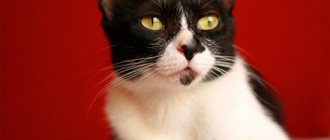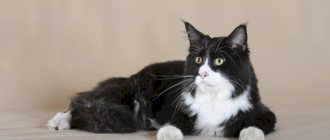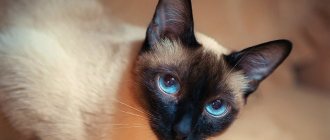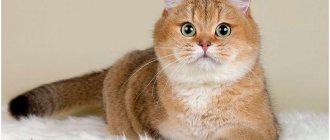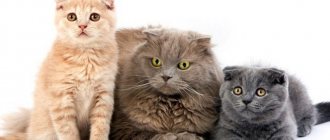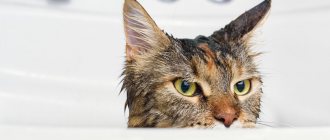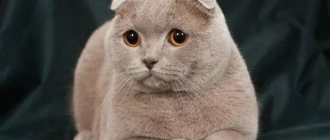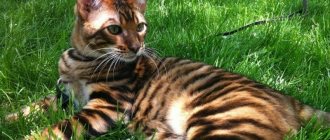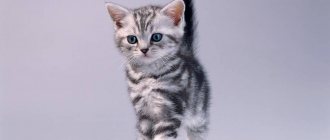Nature has endowed cats with a huge variety of colors. Against the backdrop of a wide color palette, contrasting black and white stands out. It is considered one of the most common and gives animals a special charm and nobility.
Let's figure out which cat breeds are characterized by black and white coloring.
Features of black and white color
Cats with contrasting colors are not very rare and are widespread throughout the globe. Despite its apparent simplicity, the combination of white and black has several important features:
- Uniqueness. This coloring is purely individual, so it is almost impossible to find two black and white cats with identically located spots and stains.
- Spread of color to the paws. A black and white cat may have two-color pads. Their skin is partly dark and partly pink.
- Unusual eyes. Many black and white cats have green tinted irises. Also among them are individuals with heterochromia.
- Dominance of one of the colors. Black and white cats cannot have a uniform color - one color will definitely predominate.
Interesting! In the USA, the black and white color is called “tuxedo”. Americans probably associate it with a classic men's suit, worn with a light shirt. Initially, the phrase “tuxedo color” meant an almost entirely black cat with a white mustache, “slippers” and chest.
Feeding and care
Although caring for a British Shorthair cat is not tedious, it does require some time. To maintain the appearance of the coat, it is necessary to comb the cat several times a week. You should not bathe your pet more than twice a year. You need to clean your ears and trim your nails at least once a month.
The diet of this breed, like others, must be balanced and contain all the necessary vitamins and minerals. Proper nutrition will help maintain your cat's health and appearance at a high level.
It is acceptable to feed your pet prepared food, but preference should be given to reputable manufacturers. Foods containing salt and sugar can be harmful to your cat.
Varieties of color
Although all black and white cats appear identical, this is absolutely not the case. There are 3 main varieties of this color:
Wang
With this color, the body of a black and white cat is covered with light hair with several small charcoal marks on the head, muzzle and near the tail of the animal.
Harlequin
Black and white cats with this coloration have light fur with numerous large dark markings. The charcoal pattern can combine stripes, small patterns and large areas of dark fur. The main thing is that the black spot is uniformly colored and does not have white hairs.
Bicolor
The body of an animal with this coloring is covered with blue-black fur with snow-white spots of different shapes and sizes. In the classic version, a bicolor cat has a “tie” in the chest area, as well as light markings on the sides, face and head.
Health
The British Shorthair cat is not susceptible to hereditary diseases. She is in excellent health. However, this does not mean that vaccination and preventive examinations by a veterinarian can be neglected.
It must be taken into account that sexual and physical maturation in general occurs late in the British - around the age of four. It is at this age that kittens turn into adult cats: they show all the solidity and massiveness provided for by the standards. There is no point in sounding the alarm or suspecting dystrophy until this moment.
In comfortable conditions, a Briton lives on average 15 years. However, there are record holders in the breed whose age has exceeded 20. The reasons are simple: lack of stress, active cat life, balanced food and, of course, unconditional love. The well-being of the British largely depends on feeling like a member of the family.
Color ratio
According to another, more detailed classification, black and white (b/w) color is divided into several types:
- coal-black background without clear light areas with unevenly interspersed white hairs;
- with a charcoal background and small white areas in the neck, chest or lower limbs;
- with a large, clearly defined white patch of fur on the cat's throat;
- with a mark that flows from the chin to the neck of the animal;
- with a uniform light area that starts from the chin and covers the chest, abdomen and all four limbs;
- with white bottom and sides, as well as large black markings on the back, back of the head and tail of the cat;
- with a charcoal tail and small black spots on the back;
- residual black - with several small dark markings on head and tail;
- dominant white - black pigment is present exclusively at the gene level.
GALLERY OF PHOTOS OF BRITISH CATS, CATS, KITTENS OF COLOR BI-COLOR, HARLEQUIN, VAN, TRI-COLOR
Lilac color with white British cats. Lilac bicolor British
Red (fawn) color with white British cats. Red (fawn) bicolor British
| In our cattery you can “buy a real British kitten.” We have many different colors, we will help you choose and answer all your questions! |
Breeding Features
Getting black and white kittens with the “correct” colors in any breed is very difficult. The difficulties are caused by the fact that in the bicolor color the spots must have beautiful clear outlines and not merge with each other, and the back is darkly pigmented. In addition, black and white cats with symmetrical markings are of particular value. But due to the fact that the localization of spots cannot be predicted in advance, such animals are born very rarely and are more expensive than others.
Black and white kittens arise from the mating of two-colored individuals or a bicolor cat and a cat with a tortoiseshell coat color. Moreover, the shade of the offspring’s fur coat depends on the combination of genes of the parents.
Golden chinchilla
An even rarer, difficult to breed, but very beautiful, “sunny” variety of the British cat. Its color is so named because of its similarity to the fur of real chinchillas.
This cat wears a bright apricot-colored coat with black or blue “spraying.” The brighter the gold, the more valuable it is. Gray shades are not allowed. The nose and paw pads should match the base color. The eyes are necessarily green, except for the pointed subspecies. The colors differ in the degree of coloring of the hairs.
Golden shaded
Shaded is when only the upper third of the hairs are colored in the main color. In all other respects, the animal looks like it has a solid color, only slightly “dusted.” This effect is achieved due to the fact that each hair has a colored tip. The undercoat is peach or apricot.
Golden veiled
Veiling is when the top 1/8 of the hairs are colored. In all other respects, the animal looks the same as with a solid color, only in a barely visible transparent “veil”. This effect is achieved due to the fact that each hair has a colored tip. The undercoat is peach or apricot.
Breeds of black and white cats
For a long time, the black and white color remained unrecognized by felinological systems, and purebred cats with a similar color were mercilessly discarded. The situation changed in 1969, when animals with such coats first appeared at the exhibition. Now black and white cats are found in many breeds.
British
For a long period, only blue or smoky colors were cultivated in the breed. But with the popularization of the British, their color range expanded significantly.
In addition to the standard types - van, harlequin and bicolor - among the black and white cats of this breed there are individuals with the unrecognized mitted color. It requires the presence of a light stripe between the chin and groin.
Also, black and white cats of the British breed with a mitted color should have light “socks” or “socks” on their paws.
Oriental
The standard of this breed provides for more than 200 colors, including all black and white variants. Moreover, a van, bicolor and harlequin kitten can be born in one litter. There are many varieties of black and white cats in the breed.
Among the Orientals there are also charcoal individuals with light paws and markings on the face, and snow-white animals with small contrasting spots.
Canadian Sphynx
Bicolor cats are often found among cats of this breed. Moreover, a contrasting pigment colors the skin. Black and white cats of this breed often have a charcoal tail and at least one ear. Sphynx cats are also allowed a symmetrical dark marking on the top of their head.
Kurilian and Japanese bobtails
These tailless cats also have a black and white color, which is characterized by certain features. Bicolors must have a closed white collar on the neck and a light marking on the muzzle in the shape of an inverted V.
Harlequins should have charcoal spots on the forelegs, back and head. Black and white van bobtails have a dark tail and a completely light back.
Kurilian Bobtail
Japanese Bobtail
Maine Coon
These large cats can be black and white in color. Moreover, they are more characterized by the bicolor type, in which most of the body, including the muzzle and ears, is covered in charcoal color.
Among the black and white Maine Coon cats, there are almost no individuals with the “van” and “harlequin” colors, so the cost of such animals can reach several hundred thousand rubles.
Persian
The most common color found in black and white Persian cats is the “harlequin” color, in which 5/6 of the body surface is lightly pigmented. The rest of the body is covered in a rich, cool charcoal color.
For the Persian cat breed, dark whiskers and white hairs on black spots are unacceptable.
Siberian
In addition to the usual variegated colors, the breed allows more than a dozen different colors, including a black and white version. Moreover, a fluffy Siberian can have all three types with clearly defined spots that do not overlap with each other.
The eyes of a black and white cat of this breed are pigmented yellow or green.
Turkish Angora
Although many believe that the Angora is a pure white cat, it also has other color variations. The bicolor breed has light legs, chest, collar, muzzle and belly, as well as a white mark on the forehead that looks like an inverted V.
Manx and Cymric
Tailless cats have many color options, including black and white.
Manx
Cymric
Munchkin
These cute, short-legged cats can have black and white fur. Bicolor munchkins often have light markings on their faces, “socks” on their paws, a “collar” on their necks, and a “tie” on their chests.
Cornish Rex
This figurine-like curly cat also comes in black and white. Moreover, in addition to the three main color options, the breed allows the “tuxedo” color, in which the Cornish’s chest, paws and belly are light, and the top of the head, back, shoulders and sides are charcoal.
The iris of a Rex black and white cat can be blue, yellow, olive or copper.
Turkish van
From the name of the breed it is easy to guess which type of coloring is inherent in these cats. Black and white Turkish Vans have a light body with small dark markings on the head and a charcoal tail.
Types of possible coat colors
The most common color is blue. But the colors of the British Shorthair cat are very diverse:
Two-color
A unique coat color is bicolor (two-color cats). The main background is snow-white. The second color in color (cream, black, blue, red) is presented in the form of unusual patterns. Thoroughbred representatives must have white belly, neck, chest, paws, muzzle and beard.
A prerequisite is the predominance of a white background in color. Bicolors are more valued; their body patterns are symmetrical. The eyes can be any shade, but are usually blue or golden yellow.
Cream bicolor
Cute white cats with additional streaks of delicate cream tones. The eyes are blue or yellow, and the nose and pads are pink.
Blue bicolor
The pattern on the wool is blue (delicate or rich gray). The iris of the eyes is a beautiful sky tone or yellow-orange. The nose and paws below are pink.
Black bicolor
Black and white bicolor is characterized by patterns of rich black tone. These cats have a pink nose and blue or copper eyes. A symmetrical, distinct pattern on the skin turns the cat into a real gentleman in a tailcoat.
Tortoiseshells (torties)
The tortoiseshell color of Scottish Folds is usually tri-colored. Red, white, and black spots are located on a cream or red dominant background. When the genes of the parents are combined in a tortoiseshell kitten, these markings can take on chocolate, blue and cream shades.
When assessing tortoiseshell cats, felinologists pay attention to the even distribution of markings and the intensity of their tone. Fold-eared and straight-eared Scots with a tortoiseshell color are divided into subspecies (depending on the color scheme of the spots).
Black-red
There are black and red-red patterns all over the cat's body. The sizes and shapes of the spots are very diverse. This color is often called tortie.
Chocolate red
The patterns on the wool are brown and red. They stand out against a lighter background and look very interesting. The chocolate red color is considered rare and prized by breeders.
Blue-cream
The tortoiseshell blue-cream color in Scottish pets is determined when the main gray-blue background is covered here and there with small light cream spots.
Important: tortoiseshell coloring is characteristic only of cats. The calico cat is very rare. The appearance of a male tortoiseshell kitten indicates genetic problems. Most likely, an adult pet will not be able to have offspring, since the reproductive functions of its body are impaired.
